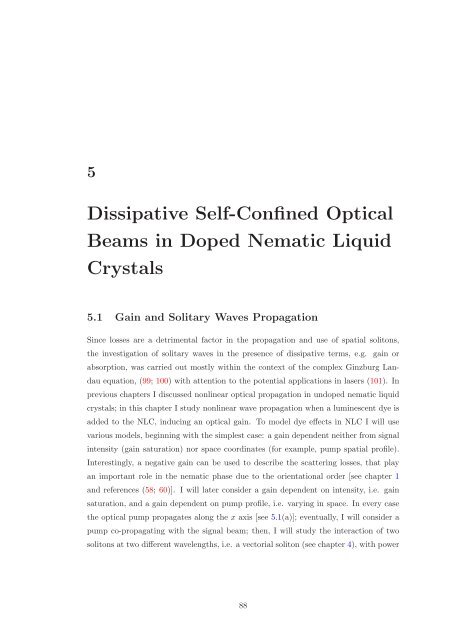Solitons in Nonlocal Media
Solitons in Nonlocal Media
Solitons in Nonlocal Media
Create successful ePaper yourself
Turn your PDF publications into a flip-book with our unique Google optimized e-Paper software.
5<br />
Dissipative Self-Conf<strong>in</strong>ed Optical<br />
Beams <strong>in</strong> Doped Nematic Liquid<br />
Crystals<br />
5.1 Ga<strong>in</strong> and Solitary Waves Propagation<br />
S<strong>in</strong>ce losses are a detrimental factor <strong>in</strong> the propagation and use of spatial solitons,<br />
the <strong>in</strong>vestigation of solitary waves <strong>in</strong> the presence of dissipative terms, e.g. ga<strong>in</strong> or<br />
absorption, was carried out mostly with<strong>in</strong> the context of the complex G<strong>in</strong>zburg Lan-<br />
dau equation, (99; 100) with attention to the potential applications <strong>in</strong> lasers (101). In<br />
previous chapters I discussed nonl<strong>in</strong>ear optical propagation <strong>in</strong> undoped nematic liquid<br />
crystals; <strong>in</strong> this chapter I study nonl<strong>in</strong>ear wave propagation when a lum<strong>in</strong>escent dye is<br />
added to the NLC, <strong>in</strong>duc<strong>in</strong>g an optical ga<strong>in</strong>. To model dye effects <strong>in</strong> NLC I will use<br />
various models, beg<strong>in</strong>n<strong>in</strong>g with the simplest case: a ga<strong>in</strong> dependent neither from signal<br />
<strong>in</strong>tensity (ga<strong>in</strong> saturation) nor space coord<strong>in</strong>ates (for example, pump spatial profile).<br />
Interest<strong>in</strong>gly, a negative ga<strong>in</strong> can be used to describe the scatter<strong>in</strong>g losses, that play<br />
an important role <strong>in</strong> the nematic phase due to the orientational order [see chapter 1<br />
and references (58; 60)]. I will later consider a ga<strong>in</strong> dependent on <strong>in</strong>tensity, i.e. ga<strong>in</strong><br />
saturation, and a ga<strong>in</strong> dependent on pump profile, i.e. vary<strong>in</strong>g <strong>in</strong> space. In every case<br />
the optical pump propagates along the x axis [see 5.1(a)]; eventually, I will consider a<br />
pump co-propagat<strong>in</strong>g with the signal beam; then, I will study the <strong>in</strong>teraction of two<br />
solitons at two different wavelengths, i.e. a vectorial soliton (see chapter 4), with power<br />
88
















